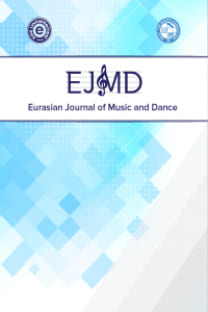EMILE JAQUES-DALCROZE ve RİTMİK YÖNTEMİ
Dalcroze, eurhythmics, solfej, doğaçlama, kinestezi, müzik eğitimi
Emile Jaques-Dalcroze and Eurhythmics
Dalcroze, eurhythmics, solfège, improvisation, kinesthesia, musical education.,
___
- Aktüze, İ. (2003). Müziği okumak. İstanbul: Pan Yayıncılık.
- Bachmann, M.L. (1991). Dalcroze Today. Editör: Stewart R., Çevirmen: Parlett,D. New York: Oxford University Press.
- Becknell, A. F. (1970). A History oft he Development of Dalcroze Eurhythmics in the U.S. and its Infulance on Public School Music Program.
- Dalcroze (t.y.). Erişim adresi https://www.musikinesis.com/artifacts-of-interest/1914-the-dalcroze-idea-what-eurhythmics-is-andwhat- it-means.
- Dresden Festspielhaus, Hellerau (t.y.). Erişim adresi https://www.archinform.net/projekte/5082.htm
- Dresden Hellerau Festspielhaus (t.y.). Erişim adresi http://www.wikizeroo.net/index.php?q=aHR0cHM6Ly9kZS53aWtpcGVkaWEub3JnL3dpa2kvRGF0ZWk6RHJlc2Rlbl9IZW xsZXJhdV9GZXN0c3BpZWxoYXVzLmpwZw
- Hall, L. D. Dalcroze (1920). Eurythmics. Francis W. Parker School Studies in Education, Vol. 6, The Individual And The Curriculum: Experiments in Adaptation, pp. 141-150
- Hellerau (t.y.) Erişim adresi https://www.google.com/search?biw=1280&bih=667&tbm=isch&sa=1&ei=PEcVXJrnJ4GsrgTV54HoDg&q=dalcroze+hella rau&oq=dalcroze+hellarau&gs_l=img.3...463252.473536..473863...1.0..2.165.2332.0j18......3....1..gws-wiz
- Jaques-Dalcroze’s Arm Beats, With Legs (t.y.) Erişim adresi https://www.musikinesis.com/ideas-to-try/jaques-dalcrozes-armbeats/
- Juntunen , M.L. (2016). The Dalcroze Approach: Experiencing and Knowing Music through the Embodied Exploration. In C. R Abril & B. Gault (Eds.)
- Kemalbay Eren, E. (2014-2018). Basılmamış Ders Notları.
- Plastique animée (2016). Erişim adresi https://lecourrier.ch/2016/06/12/la-parenthese-de-hellerau/
- Püsküllüoğlu, A. (2013). Arkadaş Türkçe Sözlük. Ankara: Arkadaş Yayınevi.
- Sadler, M. E. (1920). The eurhythmics of Jaques-Dalcroze / introduction by M. E. SADLER. London: Constable&Company LTD.
- Spector, I. (1990). Rhythm and life: the work of Emile Jaques-Dalcroze. New York: Pendragon Press Stuyvesant.
- Vanderspar E. (ty). Dalcroze Handbook Principles and Guidelines for Teaching Eurhythmics.Yyy.
- ISSN: 2651-4818
- Yayın Aralığı: Yılda 2 Sayı
- Başlangıç: 2011
- Yayıncı: Ege Üniversitesi
Derya KARABURUN DOĞAN, Caner ÇAKI
İSTANBUL RADYOSU’NUN İLK DÖNEMİNDEKİ (1927) MÜZİK YAYINLARI
OPERADA BİR TÜR OLARAK “KOMİK” KAVRAMINA İLİŞKİN YANILSAMALAR
Mehmet GİRGİN, Ebru GÜNER CANBEY
Almanya ve Hollanda’daki Türkçe Rap Sahnelerinin Karşılaştırılması
EMILE JAQUES-DALCROZE ve RİTMİK YÖNTEMİ
TÜRKİYE’DE MÜZİKOLOJİ EĞİTİMİ VEREN KURUMLARA YÖNELİK BETİMSEL BİR ÇALIŞMA
